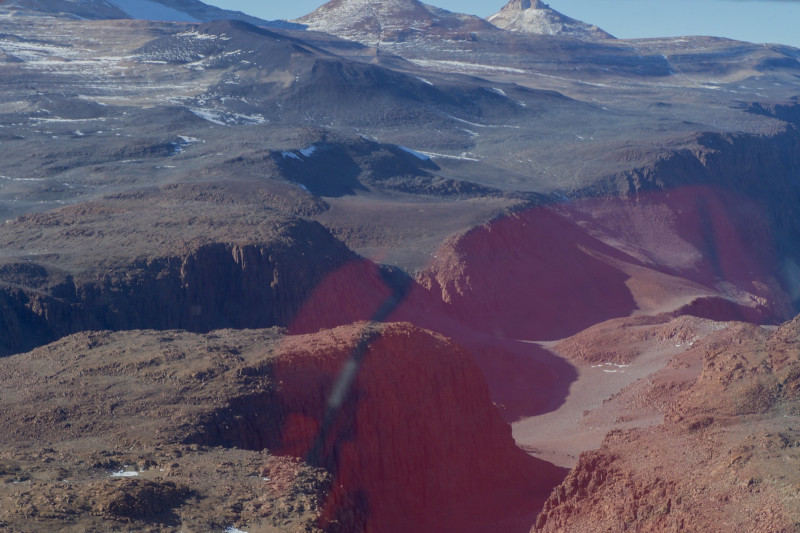
McMurdo Dry Valleys Facts
- To the great surprise of many, the region known as the McMurdo Dry Valleys easily ranks as one of the most extreme deserts known to man. This fact astounds many who learn of it, simply because most people automatically associate deserts with other attributes.
- This elevated status remains especially remarkable given one particular, extraordinary fact. That holds true because the incredible feature formed in a section of the continent now known as Antarctica. Nature, it seems, never tires of astounding us mere human beings!
- However, even in this extremely inhospitable environment, life found ways to adapt. It’s not likely the type of life most of you might expect to find. That’s because certain types of photosynthetic bacteria inhabit the comparatively damp interiors of rocks in the area.
- The wonders of evolution to be found in this breathtaking area do not end there. That holds true due to the fact that some incredible bacteria live here. More precisely, certain of these with metabolisms based entirely on sulfur and iron appear to thrive under a local glacier.
- McMurdo Dry Valleys includes a variety of geological features to amaze the explorer. These include more than a dozen separate valleys and eleven recognized glaciers. Due to a high saline content, liquid water flows in parts of the area, including streams and small lakes!
- Thankfully, this wonder now enjoys another form of protection from the depredations of man. The region forms part of the Antarctic Specially Protected Areas (ASPA), which authorities designated for scientific research and conservation, under the Antarctic Treaty System.
Related Articles
Maine Desert
McMurdo Dry Valleys Geology
Intriguingly, the stunning McMurdo Dry Valleys formed in conjunction with a significantly larger formation. That’s what the majority of professional geologists call the Beacon Supergroup. This structure formed during a period ranging from 400 – 250 million years in the distant past.
Yet the wonders continue. The unparalled region also cuts through sections of even older rock formations, largely consisting of various types of granite. Relatively large quantities of unsorted glacial sediment, commonly known as tills, also cover the exposed areas of bedrock.
These deposits, in themselves scientifically fascinating, appear in widely scattered pockets. These largely differ in composition from tills found in other parts of the world. Most others remain rich in mud. This rather sharp contrast occurs as a result of the unique nature of their origin.
In the remarkable McMurdo Dry Valleys, the numerous tills deposited over vast spans of time from extremely cold-based ice. Similar deposits in other regions, however, formed as primarily moist-based. Due to these factors, large amounts of loose gravel also dot the landscape of the region.
McMurdo Dry Valleys Location and Climate
To the astonishment of many, the McMurdo Dry Valleys formed in a remote corner of the globe. That region’s generally better known for the presence of fascinating, if comparatively limited in number, forms of life. These formed among the southernmost regions of the Southern Hemisphere.
Specifically, the powerful natural processes that created this marvel did so in what’s now known as the Transantarctic Mountain Range. Within that greater region, though, its precise placement puts the valleys inside the region named Victoria Land, situated somewhat north of the Ross Sea.
This geological wonder also sits roughly due west of the site presently known as McMurdo Sound. The austerely beautiful region additionally boasts a total area measuring roughly 1,900 sq mi (4,800 sq km). This accounts for a respectable 0.03% of the total area of the entire continent.
This marvelous setting also, unsurprisingly, represents the largest ice-free region of the continent of Antarctica. The fascinating section of the world derives its name from its remarkable climate. That’s because, despite its location, it still remains one of the most arid places on the planet.
This extreme lack of humidity contributes to, but does not solely account for, the nearly complete lack of any permanent accumulations of snow or ice. The miniscule average precipitation of only 100 mm per year also occurs due to the relatively great height of the surrounding mountains.
These natural features, in themselves individually awesome, typically serve to prevent the advance of the local ice sheet. This fact plays yet another part in the nature of the valleys. Yet, the extreme winds found in the region, known as katabatic winds, also play a pivotal role in its aridity.
These incredibly powerful, relatively warm winds, present within the McMurdo Dry Valleys, often achieve astounding speeds equaling as much as 200 mph (320 kph). These powerful natural currents, therefore, continually serve to rapidly evaporate any recently deposited ice or snow.
Features Sharing Its Region
Check out our other articles on Astounding Lizards of the World, Little Penguin, Dallol Hydrothermal Field, Culpeo, Lady’s Slipper Orchid, Death’s-head Hawkmoth, Aye-aye, Pea Blue
